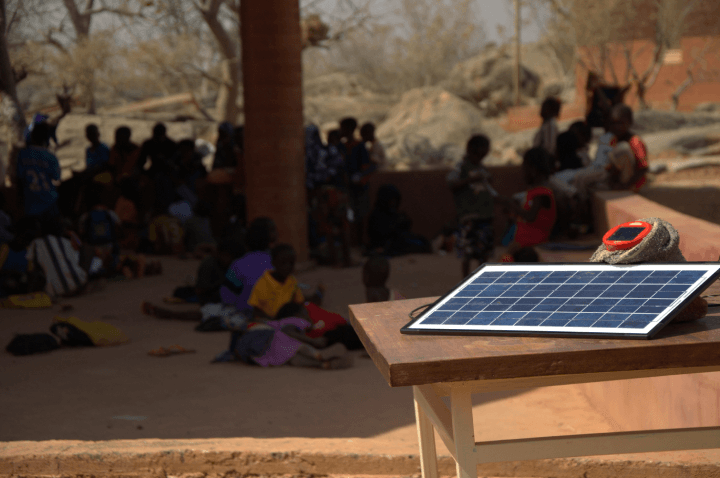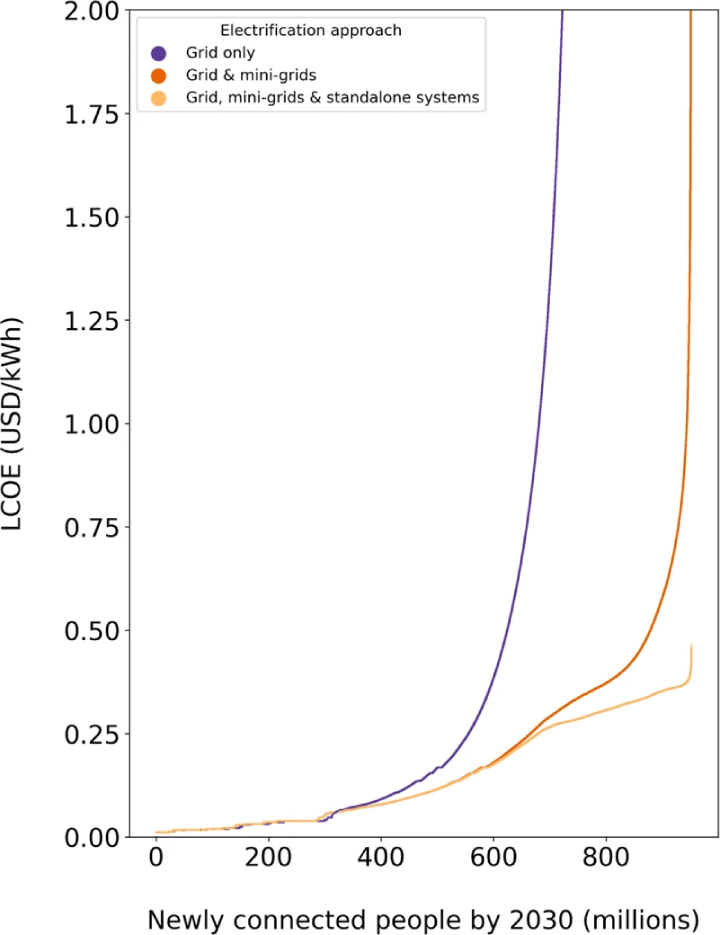Solar Cells & Batteries: Africa's Electrification Hope
Environment | 26-09-2023 | By Liam Critchley
Studies have estimated that 752 million people in the world lacked access to electricity in 2020, 581 million of whom live in sub-Saharan Africa. The United Nations (UN) has stipulated that they’d like to provide access to affordable, reliable, sustainable, and modern energy for all, and this is one of their cornerstone development goals—Sustainable Development Goal (SDG) number 7.
The quest for universal electrification, especially in regions like sub-Saharan Africa, is not merely a matter of infrastructure. It's a complex interplay of technological advancements, economic feasibility, and socio-political factors. As the global community strives to achieve the United Nations SDG7, it's imperative to understand the nuances of this challenge.
 On January 10th, 2014, in Ouagadougou, Burkina Faso, a small solar cell panel was displayed in front of students at Operndorf Schlingensief.
On January 10th, 2014, in Ouagadougou, Burkina Faso, a small solar cell panel was displayed in front of students at Operndorf Schlingensief.
Electrification in Sub-Saharan Africa
SGD7 is focusing on providing universal access to affordable, reliable, and modern energy services by 2030, and a big part of achieving this target is the electrification of the sub-Saharan African region. Aside from meeting sustainability goals, it’s believed that the electricity demand in Africa is going to grow over the next few decades.
It's not just about powering homes and businesses; electrification can be a catalyst for socio-economic transformation. Access to reliable energy can spur innovation, enhance education, and improve healthcare services, thereby elevating the overall quality of life.
Steady progress has been made in sub-Saharan Africa regarding electrification, but the COVID-19 pandemic in 2020 dealt a blow to this progress. Coupled with continued population growth, the number of people who don’t have access to electricity increased for the first time since 2013.
Challenges and Innovations
The ramifications of the COVID-19 pandemic have been multifaceted, affecting not just health but also socio-economic progress. The setback in electrification efforts is a testament to the intricate challenges that unforeseen global events can pose. Yet, adversity often breeds innovation, prompting nations to rethink and recalibrate their strategies.
There are still currently many challenges that are present for the widespread electrification of sub-Saharan Africa, but there is also promise. Government budgets in many countries are constrained, both in part due to an economic downturn during COVID and the levels of unsustainable debt faced by these governments—both of which limit public investment into new social solutions.
While financial constraints are a significant hurdle, they also highlight the need for innovative, cost-effective solutions. The emphasis is shifting from traditional, high-investment electrification methods to more agile, scalable, and sustainable alternatives.
But on the other side, the components and technologies required for widespread off-grid electrification—such as solar cells and batteries—are not only becoming more advanced, but they are also getting cheaper. This means that the overall costs for low-carbon off-grid electrification have decreased significantly in the last few years, making them more accessible for countries that couldn’t even begin to consider their widespread implementation just a few years ago. This offers the potential for some countries in sub-Saharan Africa to obtain electrification without needing to go via the traditional and more infrastructure-intensive route of power grid extension.
The evolution of off-grid electrification technologies, particularly solar cells and batteries, is a beacon of hope. As these technologies become more advanced and affordable, they present a viable solution for regions where traditional power grids might be impractical or economically unfeasible.
Remote electrification via renewable technologies on a global scale could help the UN to reach the goals of SGD7 and at a lower cost. However, while this infrastructure approach is going to be cheaper and more accessible than extending the national power grids, the cost to the consumer in different regions is still unclear. So, while it may be economically feasible for governments to implement these strategies, it may not be economically feasible for the consumer—in which case, the approach would not be suitable.
The affordability gap underscores the importance of not just technological innovation but also socio-economic considerations. It's crucial to strike a balance between state-of-the-art solutions and the real-world ability of communities to access and benefit from them.
Without knowing these details, local governments and decision-makers run the risk of building infrastructure that can’t be used by the local population because they can’t pay for its use—wasting a lot of time, money, and resources in the process. This is known as the affordability gap and could affect the success of electrification in low-income countries. A new study has just come out that has looked at how much it would cost for the average consumer in sub-Saharan Africa if these electrification initiatives were installed.
Such studies are pivotal in shaping the future of electrification efforts. By understanding the economic implications at a granular level, policymakers can tailor strategies that are both technologically sound and economically viable for the end-users.
New Study Highlights the Cost of Electrifying Sub-Saharan Africa
The electrification of the sub-Saharan region of Africa will require major investment, but the analyses done to date have focused on the cost of energy aggregation. But it is unclear whether SGD7 can be met and whether it is possible for all to have access to affordable, reliable, sustainable, and modern energy.
Researchers have used an electrification model called OnSSET to estimate the cost per person per day (pp/d) across 40 countries in the sub-Saharan Africa region. The researchers produced sub-Saharan Africa-wide and country-specific cost curves to identify any areas where people may not be able to pay based on the cheapest available electrification option. The researchers looked at different electrification technologies, including grid extension, hydro technology, solar PV mini-grid, and solar PV standalone systems, to see which ones could theoretically achieve 100% electrification by 2030 (as set out in the SGD7 goal).

When you look at the x-axis, it's showing the folks we're aiming to get electricity to by 2030. This takes into account how our population's growing and where we're at with electrification right now. We're focusing on Tier 3 results here. Just a heads-up: because of the population boom in areas without electricity, the number of people we're connecting (that's on the x-axis) is actually more than the current number without power, which is around 580 million.
The model considered population growth, population density, realistic financing conditions and technology cost. The model also used the World Bank’s Multi-Tier Framework for Energy Access to factor in energy access, as it provides a classification of the average annual household electricity usage.
The study found that solar technology systems—both the PV mini-grids and standalone systems were the prime options for lowering the cost of electrifying remote and high-cost areas. On average, it was found that the lowest cost electrification approach across the sub-Saharan region came out at 14c USD/kWh or 3c USD pp/d. The results also showed some big variations between countries, with the average costs ranging from 3c USD pp/d in Gabon to 16c USD pp/d in Eswatini—but even the higher end is still relatively low.
These results were based on the consumption of around 365 kWh per household per year (tier 3 level energy consumption). These values are sensitive to demand, though, as overestimating demand and building too large of an infrastructure could lead to increased costs. This is seen as a critical aspect as the results also showed variances within countries, as well as from country to country. If the local population only had basic electricity access (known as tier 2 consumption), it has been shown that the costs pp/d could remain below 5c USD for all sub-Saharan countries.
Conclusion
The results show that electrification planning needs to consider the variance in electricity cost and consumption from country to country to ensure that it is feasible on a local level—otherwise, the customers are not going to be able to pay, and there will need to be large public subsidies to cover the deficit. The study has shown that achieving 100% electrification in sub-Saharan Africa is feasible and could meet the goals of the UN SDG7 if policymakers make full use of available off-grid technologies to substantially reduce the cost to economically feasible levels.
References:

